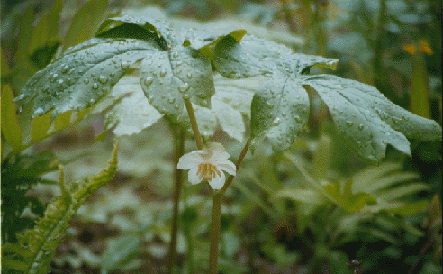Welcome to the Vassar College Priscilla Bullitt Collins ’42 Trail, a part of Vassar's Native Plant Preserve that winds through a small wetlands. The trail is located right on the main campus across the Fonteyne Kill from the Shakespeare Garden and behind the Skinner Hall of Music.
The boardwalk (which is wheelchair accessible) runs the length of this natural wetlands, following the Fonteyne Kill, with a branch of the walk cutting diagonally across the middle of the area.
The boardwalk can be entered from three different locations. One entrance is near the bridge behind Olmsted and the other two are located on the path leading from Sunset Lake to the South Lot Parking Area. A beautiful stone wall built by the Class of 1961 borders this end of the wetlands and connects the two boardwalk entrances.

What is a Wetlands?
A wetlands is an area whose soil is saturated with water or submerged, either permanently or for a prolonged period during the growing season. Such conditions are often indiscernible when visiting a site and so it is best to take into account a variety of wetlands indicators to determine the existence and the boundaries of a wetlands area. Due to the ease of visual identification, vegetation is frequently used as an indicator. Plants specially adapted to wet conditions are called hydrophytes and are found primarily in wetlands locations. Other indicators include topography, soil composition, and, the most important, hydrology. When all of these indicators are taken into consideration one can get a reliable identification of the presence of a wetlands.
Essentially, wetlands encompass the ill-defined landscape between dry land and fully aquatic areas. As such their needs are often over-looked or abused, and their benefits can go unappreciated. The various functions of the wetlands provide its greatest value. Sometimes called the 'kidneys' of the natural ecosystem, the wetlands serve as essential protectors of the waters of the Earth:
- Stabilization of the waterflow in streams and rivers is managed by the absorption and retention of excess rainfall into the wetlands, which can prevent flooding. During dry seasons this excess is then released back into the waterways.
- The wetlands work to clean polluted water. Chemicals, pesticides, and heavy metals are bound or broken down in the wet soils.
The wetlands also protect and nurture life:
- Plants and animals create a niche for themselves in the specialized conditions of wetlands, many of these are considered rare and unusual.
A significant wildlife habitat demands certain criteria including: size (large enough to sustain a number of species without crowding), location (next to open water), surrounding habitats (a safe corridor between habitats for traverse back and forth), vegetative diversity (to appeal to different species), cover types (for nesting and protection), water chemistry (pH>7.5 is most valuable), and access difficulty (to restrain human intervention). The potential exists for a diverse plant and wildlife population when these factors are present in the wetlands.
Other Resources of Interest:


